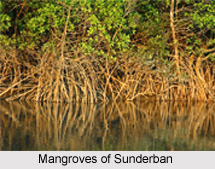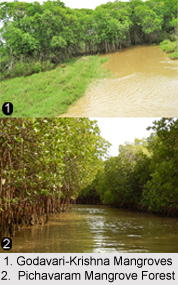 Mangrove in India is world famous for its rich variety of flora and fauna and also for its huge area. The Mangroves are actually salt-tolerant plants of tropical and subtropical inter-tidal regions and they are mainly found in the Godavari-Krishna and Sunderban regions in India. In the regions where these plants grows are termed as "Mangrove Ecosystem". These plants are extremely sensitive and fragile. The Sunderban comprise the principal portion of Mangrove in India. The ‘Sunderban Mangroves’ occupy a huge area followed by the Andaman-Nicobar Islands and Gulf of Kutch in Gujarat. Compared to the Sunderban, the rest of the mangrove ecosystems are comparatively smaller.
Mangrove in India is world famous for its rich variety of flora and fauna and also for its huge area. The Mangroves are actually salt-tolerant plants of tropical and subtropical inter-tidal regions and they are mainly found in the Godavari-Krishna and Sunderban regions in India. In the regions where these plants grows are termed as "Mangrove Ecosystem". These plants are extremely sensitive and fragile. The Sunderban comprise the principal portion of Mangrove in India. The ‘Sunderban Mangroves’ occupy a huge area followed by the Andaman-Nicobar Islands and Gulf of Kutch in Gujarat. Compared to the Sunderban, the rest of the mangrove ecosystems are comparatively smaller.Etymology of Mangrove
The word 'Mangrove' is considered to be a combination of the Portuguese word ‘Mangue’ and the English word ‘Grove’. The word is broadly used to refer to the habitat and entire plant assemblage or mangal, for which the terms mangrove swamp and mangrove forest are also used. Apart from that, Mangrove is also used to refer to all trees and large shrubs in the mangal. It is narrowly used to refer to the mangrove family of plants, the Rhizophoraceae, or even more specifically just to mangrove trees of the genus Rhizophora, as well.
Flora and Fauna of Mangrove Ecosystem
The Mangrove in India is home to numerous species of flora and fauna and the presence of Mangrove ecosystems on coastline can save lives and property during natural hazards like cyclones, storm surges and erosion, as well. The Mangrove in India is home to a large number of over 1600 plant and 3700 animal species. The most notable species of Mangrove in India include the major components like "Acanthaceae", "Avicenniaceae" or "Verbenaceae" (Black mangrove), "Combretaceae" (Buttonwood, White Mangrove), "Arecaceae" (Mangrove Palm), "Rhizophoraceae" (Red Mangrove), "Lythraceae" (Mangrove Apple) etc. families.
 Mangrove in India includes numerous species that helps maintaining the balance of ecosystem in India. The Mangrove in India is breeding, feeding and providing nursery grounds for many estuarine and marine organisms. The ecosystem has quite a large potential for natural products that can be used for medicinal purposes and also for salt production, apiculture, fuel and fodder, etc.
Mangrove in India includes numerous species that helps maintaining the balance of ecosystem in India. The Mangrove in India is breeding, feeding and providing nursery grounds for many estuarine and marine organisms. The ecosystem has quite a large potential for natural products that can be used for medicinal purposes and also for salt production, apiculture, fuel and fodder, etc.Significance of Mangrove in India
Mangrove in India protects the coast from erosion, surge storms especially during hurricanes and tsunamis and their massive root system is efficient in breaking up the wave energy. Similarly, the mangroves also slow down tidal water enough so that its sediment is deposited as the tide comes in and is not re-suspended when the tide leaves, except for fine particles. By doing so, the mangroves build their own environment. This uniqueness of the mangrove ecosystems and their protection against erosion often makes Mangrove the object of conservation programs including national ‘Biodiversity Action Plans’. It has been found several times that the wave energy is typically low in the areas where mangroves grow. The Mangrove in India also supports ecosystems, adapt low oxygen, limits salt intake and water loss, and also increase survival of offspring.
For more, visit the link below:
https://www.indianetzone.com/40/mangrove_india.htm
https://www.indianetzone.com/40/mangrove_india.htm